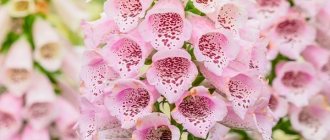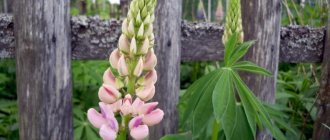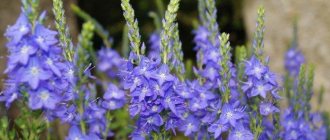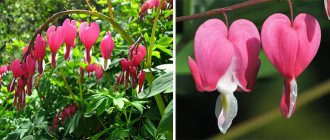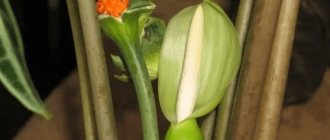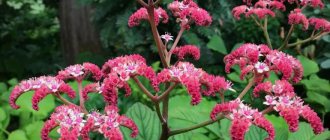For native plant enthusiasts, Perennial Lupine is preferred over Russell hybrids and other hybrid lupins that most people grow as garden plants. Perennial lupine, commonly known as wild lupine, native lupine, or blue lupine, is found throughout much of eastern North America, as well as along the shores of the Arctic Ocean. Once extremely common, its range has decreased significantly as a result of human development. And because it is an important food source for the caterpillars of several endangered butterfly species, the plant is attracting new interest as a garden plant and in wildflower restoration projects.
Wild blue lupine is very similar to the more colorful hybrid lupins, with distinctive palmate leaves that are attractive in the garden even when the plant is not in flower. Spiny blue inflorescences 10 to 25 centimeters tall appear in late spring or early summer on plants up to 60 centimeters tall. Perennial Lupine plants tend to be more muted in color than the piercingly bright caramel colors of hybrid lupins—usually blue or purple, but sometimes white or pink.
These flowers are herbaceous perennials and members of the pea family. Thus, they are nitrogen fixers. They actually improve the soil in which they are planted. Lupine is usually planted in the spring, either from potted nurseries or from seeds sown directly in the garden. For wild species, seedlings can be difficult to find, so you may have to buy seeds from a specialty store.
Like hybrid lupins, native Lupine perennial is a relatively short-lived perennial plant. It sometimes does not bloom until its second year, and individual plants may live no more than three to four years. But wild lupine self-seeds very easily, and once the bed is established, you will have reliable blooms every year.
Caring for perennial lupine
This native species is grown in much the same way as the more common hybrid garden lupins. Lupins, with their long tap roots, are one of those fussy plants that don't like to be transplanted. For this reason, it is best to try planting them directly into the garden. Lupines love cool weather and do not respond well to combinations of heat and humidity. In fact, some gardeners who once thrived with lupine are beginning to realize that climate change is making it difficult to grow the plant in their regions, while gardeners in very cool zones are finding a new delight in lupine.
Community of little green men
Lupinus, Lupin. One-, two- and perennial rhizomatous plants form a powerful bush (up to 80-120 cm in height) with straight stems and beautiful palmate leaves collected in a rosette. The stems are crowned with racemose inflorescences with flowers of various colors: white, yellow, blue, purple, pink, cream, carmine, red, purple. Flowering time is mid-summer.
Etymology
Derived from the Latin lupus - “wolf”: according to the plant’s ability to tolerate the most unfavorable soil conditions.
Types and varieties
The genus consists of 200 species growing on the slopes of the rocky mountains of North America and the Mediterranean. In decorative floriculture, one species is widespread: multileaf lupine (Lupinus polyphyllus), but recently, thanks to selection, species grown as seasonal annuals have also become popular, for example, low lupine (Lupinus nanus), which has varieties with beautiful fragrant flowers.
Multileaf lupine (Lupinus polyphyllus)
A perennial plant up to 120 cm high. The stems are straight, the leaves are palmate, the flowers are blue, collected in multi-flowered racemose inflorescences 30-35 cm long. Blooms in June for 20-30 days. It comes in varieties with single or bicolor flowers of red, white, pink, yellow and orange.
Popular varieties of multileaf lupine:
'Abendglut' - up to 100 cm high, dark red flowers;
'Apricot' - up to 90 cm high with orange flowers;
'Neue Spielarten' - up to 110 cm high, pink-orange flowers;
'Roseus' - up to 110 cm high, pink flowers;
'Rubinkonig' - up to 100 cm high, ruby-purple flowers.
Russell Lupines (Russell Hybrids, Russell Lupine)
In 1911, the British amateur breeder George Russell created a new highly decorative group of lupins, which were named Russell's lupins in his honor and gained great popularity among amateur gardeners.
Due to the wide variety of shapes and colors, Russell hybrids can be widely used in landscaping and for cutting. In Russia, Russell's lupins are often sold in mixtures under the commercial name "Russell's" lupine.
Russell lupins are unpretentious, fast-growing perennials suitable for planting in sunny or shady locations with light, sandy loam, well-drained soils.
Russell lupine varieties:
'Governor' - plant 100 cm high, inflorescence blue and white;
'Chatelaine' - plant 100 cm high, pink inflorescence;
'Chandelier' - plant 100 cm high, yellow-orange inflorescence;
'Page' is a plant 100 cm high, red inflorescence.
Annual lupins
Recently, thanks to selection, lupins grown as seasonal annuals, for example hybrid lupine
( Lupinus x hybridus), have become popular.
Under this name, hybrids of various annual species, their varieties and varieties are combined. Thus, seasonal annuals include dwarf lupine (Lupinus nanus), changeable lupine (Lupinus mutabilis var. cruckshanksii) and Hartweg lupine (L. hartwegii).
Annual lupins are fast-growing plants, up to 100 cm high, with racemose inflorescences of various colors (white, blue, indigo, yellow, pink, red, dark red or variegated). Annual lupins bloom from early summer until autumn.
A popular variety of annual dwarf lupine is ' Pink Fairy' ('Pink Fairy' or 'Pink Fairy', 'Pink Fairy')
- a plant that has gained immense popularity due to its unusual aroma of sweet peas. The variety blooms, reaching a height of only 30 cm. It forms numerous side shoots that hide faded inflorescences, maintaining the attractive appearance of the plant until frost. The color of the inflorescence ranges from pink-white at the bottom of the inflorescence to pure white at the top.
Care
Sunny and semi-shaded areas. It is undemanding to soils, but achieves best development on well-moistened, loamy, slightly acidic or slightly alkaline soils. During drought, they require abundant watering at the root. In the first year, the soil must be loosened and weeds removed. Old plants are hilled to form lateral roots and prolong their decorative effect. Plants are replaced every four years.
Reproduction
Propagated only by seeds. It is better to sow perennial species before winter in a permanent place (the first flowering will occur in August next year), annual species - at the end of April (plants will bloom from the end of June to the end of August).
Is lupine toxic?
Perennial lupine is a type of lupin that is toxic to humans and animals. All parts of plants, but especially seeds, contain various types of quinolizidine alkaloids. Alkaloids are found in many plants as an evolutionary adaptation that protects the plant from insect pests and animals. Some of these alkaloids, including those found in some types of lupine, can be fatal if ingested in very large quantities by people or pets. However, the seeds are bitter, so serious poisoning is rare, except in grazing animals such as goats and horses.
Pests and diseases of lupine
If agricultural practices are followed, the North American guest practically does not get sick. For the crop, it is important to observe crop rotation and not plant new individuals in the same place for at least 3 years. The danger for exotics is:
- aphid;
- germ flies;
- nodule weevil;
- various types of rot;
- rust;
- Phomopsis (spotting);
- mosaic;
- Fusarium
The appearance of a colony of aphids on buds causes trouble for the gardener. To destroy the pest, do not rush to use chemicals. It is enough to spray the candles with a solution of laundry soap or garlic infusion and the tiny beetles will die.
The larvae of germ flies feed on seeds planted in the ground, climbing inside and damaging the embryo. After sowing, the soil is watered with a solution of the Iskra preparation.
The nodule weevil is a very voracious beetle. He is able to eat up to 2 kg of foliage per day! If you notice signs of damage to the records, apply a systemic insecticide.
Rot, rust, Phomopsis, Fusarium are diseases caused by fungi. As the mycelium grows, various spots and signs of deterioration appear. Remove the affected parts and spray with a fungicide.
Remember! Mosaic, which appears in the form of characteristic spots, refers to plant viruses. There is no cure for this scourge, so remove infected individuals immediately.
Reproduction of perennial lupins
These plants are prolific self-sowers and small volunteer seedlings from the garden can be transplanted. However, do this when they are still small, as the plants quickly develop deep taproots that do not like transplanting. You can also collect the seed pods, remove and dry the seeds, and then replant them in your desired locations.
Features of growing a plant
If you decide to grow colorful candles in your garden, be prepared to wait a whole year for them to appear. Grown seedlings bloom only in the second year. They do not require specific care. Wolf beans can be grown by seedlings and direct sowing in the ground.
Although exotic is considered a perennial and lives up to 10 years, when the bush reaches five years of age, you may notice partial death. After 5-6 years, replace the bushes with young shoots. This must be taken into account if you want to enjoy flowering without the interruptions necessary for growing seedlings.
Flower in folk medicine
Decoction for scars
A tablespoon of ground seeds is soaked overnight and boiled for ten minutes in the morning. Apply a compress daily. Or crushed, overripe seeds are combined with vegetable oil. Let it sit for a week. Used to treat damaged skin surfaces.
You may also be interested in: Lavender properties
Decoction for staphylococcus
- two hundred fifty grams of leaves
- yarrow - three hundred grams
- horsetail herb, dandelion roots, chamomile flowers and burdock leaf, calendula - 250g collection (50g each)
- one hundred grams of plantain, sweet clover and nettle
A concentrated decoction is made from the listed herbs. Take a tablespoon fifteen minutes before meals.
Healing ointment - 2 recipes
Ground barley and lupine seeds are combined in equal quantities and brewed with boiling water. Take a little boiling water. You should get a thick, viscous mass, which is applied to the problem area.
Or mix 1 tsp. seeds, 2 tbsp. vinegar, honey - a tablespoon. A compress is made from the mixture and taken orally before meals. Homemade ointment perfectly heals and disinfects wounds; positive results are known in the treatment of gangrene.
Flower for the liver
A tablespoon of lupine seed oil, flower honey - 1 tbsp, grape juice - 2 tbsp. The mixture is taken before meals. When consumed daily for ten days, the patient’s general condition improves and appetite appears.
Lupine for worms
An excellent remedy for getting rid of the problem can be a mixture of lupine and honey, taken in equal quantities. The mixture is taken orally and the navel area is treated in a circular motion for ten minutes.
Or green leaves (200g) mixed with two pinches of black pepper, a spoonful of finely chopped rue herb and honey with the addition of half a glass of table vinegar. The product is strong, there are contraindications for use, it can terminate a pregnancy.
Planting seedlings in open ground
The bed for lupines begins to be prepared in the fall. If the soil is too acidic, sprinkle it with lime flour, at the rate of 0.5 -0.7 kg of the drug per 1 sq. m. meter. Peat is added to the alkaline solution.
Grown sprouts can be planted in open ground after the threat of night frosts has completely disappeared. Each region has its own timing of the onset of heat. Holes are dug at a distance of 50 cm. Perennial lupine grows slowly, the space between the bushes in the first two years must be filled with annual flowers.
A few hours before transplanting, the seedlings are watered abundantly. It will be easier to remove young shoots from soggy soil without damaging their root system. Seedlings growing in peat pots are planted in a flowerbed along with a container. This method of planting seedlings is the most profitable because the roots of the flowers are not stressed.
Annual varieties are planted in the garden between rows. Perennial lupins are more suitable for flower beds and flower borders. The crop is planted in previously prepared furrows or holes. You need to water the plants carefully, right at the root.
Lupine - soil requirements
Lupins are not too demanding on the substrate. In nature, these flowers prefer drier places, so it is recommended to provide them with well-drained soil that does not retain water. However, it does not have to be very fertile; the reaction can vary from neutral to slightly acidic. In sandier or rockier areas, plants develop strong, long roots.
Flowering is highly dependent on the amount of light, so plant lupins in sunny or perhaps semi-sunny locations. The more shade, the less abundant the flowers will be.
Lupine as green manure and fertilizer
Green manures are natural green fertilizers. Thanks to the structure of the root system and symbiosis with nitrogen-fixing bacteria, representatives of the legume family saturate the soil with nitrogen, replacing organic matter. Another advantage is the developed network of small roots, which improves the structure of the soil. Tiny roots dig into the soil, improving aeration.
To turn a flower into fertilizer, it must be planted in the required area, and after flowering, when the beans turn silver, it must be embedded in the soil using a special tool - a flat cutter. It resembles a hoe with a long handle, which I use to cut greenery without disturbing the soil structure.
This is interesting! The roots accumulate up to 20 g of easily digestible nitrogen per square meter. In addition to nitrogen, the earth is saturated with potassium and phosphorus.
Popular types and varieties
In the gardens, mainly perennial varieties of multi-leaf hybrids of American origin are grown. Most of them were bred by breeder George Russell more than 100 years ago. The Russell group contains plants with flowers of various colors. These are very winter-hardy flowers, now distributed throughout the globe. The most popular remain:
- Castle (MyCastle, MeinSchloss) - tall plants with brick-red flowers;
- Candelabra (Chandelier, Kronleuchter) - a spectacular plant with a lemon-yellow brush;
- Governor (Governor, Kastelan) – blue-violet color with a white sail;
- City Woman (BurgFreulein) – with completely white flowers;
- Beautiful Lady (Schlossfrau) – with pink and white tassels;
- Descendant of the Aristocrat (Edelknabe) – carmine-red flowers.
Modern breeders continue to work in the field of lupine hybridization, and new varieties appear every year. Of interest are miniature and dwarf varieties, as well as hybrids that bloom in the first year. However, Russell's hybrids are unsurpassed classics.
Care after flowering
The special structure of the inflorescences allows the use of lupins in landscape design. However, to preserve their beauty, it is necessary to properly care for the plants after flowering.
What time to collect seeds
Fully ripe lupine pods burst and the seeds scatter on the ground. To collect planting material, cut off the pods that have begun to turn yellow and dry.
Technology of sowing lupine seeds for seedlings
One of the easiest ways to grow lupine is from seedlings. It is not complicated and does not differ much from sowing other garden plants, but still the technology has its own characteristics. To sow seeds correctly, you must follow certain steps.
Preparing the container and soil
First you need to prepare the soil mixture. It should be light and allow water and air to pass through well. Before using the soil, it is necessary to disinfect it - this applies to both purchased mixtures and those prepared at home. This can be done by frying in the oven or scalding with boiling water.
The container can also be disinfected; just wash it with a solution of potassium permanganate.
Dates and rules of sowing
The sooner you sow seeds for seedlings, the better. The optimal time for this is the end of February or the beginning of March. It is necessary to fill the prepared container with soil, compact it a little and pour water at room temperature.
Before sowing the seeds, they need to be prepared. To do this, you will need to mix the planting material with powder obtained from crushed roots of adult lupins. This procedure will accelerate the growth of nitrogen-absorbing bacteria, the seedlings will become strong and develop faster.
Then the seeds are immersed in the soil to a depth of no more than 1.5 cm, at a distance of 5 cm from each other. After which they must be sprinkled with 5 mm of soil and watered with warm water. At the end of sowing, the container must be covered with film and placed in a warm, well-lit place.
How to cut the seed coat
In order to obtain high germination rates of beans (this is what flower seeds look like), it is necessary to slightly break their protective shell. This can be done in several ways:
- Wrap a few beans in a sheet of sandpaper and rub thoroughly. In this case, the seed coat is scratched and the percentage of germination increases.
- The protective shell can be slightly cut using a sharp object.
Thanks to such simple procedures, the seeds will swell faster and germinate well.
Plant diving
Lupine does not tolerate transplantation very well, so it is advisable to sow it in cups to avoid picking. But if the plant was sown in a common container, it must be replanted as soon as two or three cotyledon leaves appear
It is important not to miss this moment, since later replanting can damage the taproot of the crop.

